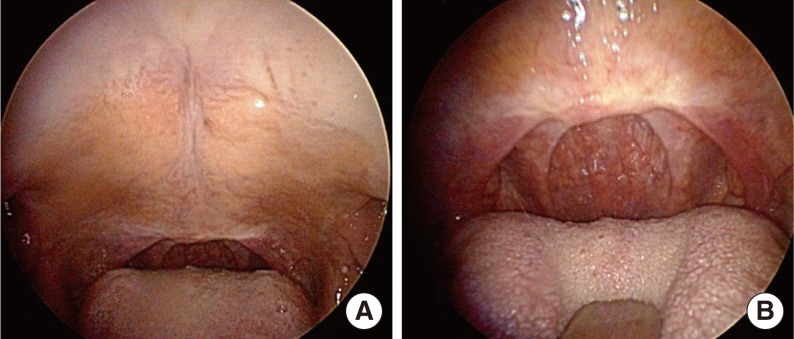Clin Exp Otorhinolaryngol.
2014 Mar;7(1):66-68.
Palatal Implants for Persistent Snoring and Mild Obstructive Sleep Apnea After Laser-Assisted Uvulopalatoplasty
- Affiliations
-
- 1Department of Otorhinolaryngology-Head and Neck Surgery, Korea University College of Medicine, Seoul, Korea. shleeent@korea.ac.kr
Abstract
- Laser-assisted uvulopalatoplasty (LAUP) was widely performed in 1990s as a surgical therapeutic procedure to improve snoring or mild obstructive sleep apnea (OSA). However, LAUP is not currently recommended as a treatment for OSA because the evidence for its efficacy is insufficient. Little is known about alternative minimally invasive surgery in patients who refuse continuous positive airway pressure or oral appliance after failed LAUP. We present a case of successful surgical treatment of persistent snoring and mild OSA with palatal implants after LAUP. This case suggests that palatal implants may be offered as an alternative surgical procedure for selective patients with persistent or recurrent snoring or mild OSA after LAUP.
Keyword
MeSH Terms
Figure
Reference
-
1. Powell NB. Contemporary surgery for obstructive sleep apnea syndrome. Clin Exp Otorhinolaryngol. 2009; 9. 2(3):107–114. PMID: 19784401.
Article2. Kamami YV. Laser CO2 for snoring: preliminary results. Acta Otorhinolaryngol Belg. 1990; 44(4):451–456. PMID: 2128762.3. Kamami YV. Outpatient treatment of snoring with CO2 laser: laser-assisted UPPP. J Otolaryngol. 1994; 12. 23(6):391–394. PMID: 7897766.4. Aurora RN, Casey KR, Kristo D, Auerbach S, Bista SR, Chowdhuri S, et al. Practice parameters for the surgical modifications of the upper airway for obstructive sleep apnea in adults. Sleep. 2010; 10. 33(10):1408–1413. PMID: 21061864.
Article5. Friedman M, Schalch P, Joseph NJ. Palatal stiffening after failed uvulopalatopharyngoplasty with the Pillar Implant System. Laryngoscope. 2006; 11. 116(11):1956–1961. PMID: 17075397.
Article6. O'Connor-Reina C, Garcia-Iriarte MT, Casado-Morente JC, Gomez-Angel D, Rodriguez-Diaz A, Plaza-Mayor G. Snoring surgery with palatal implants after failed uvulopalatopharyngoplasty. Eur Arch Otorhinolaryngol. 2008; 6. 265(6):687–693. PMID: 18030486.7. Friedman M, Ibrahim H, Bass L. Clinical staging for sleep-disordered breathing. Otolaryngol Head Neck Surg. 2002; 7. 127(1):13–21. PMID: 12161725.
Article8. Ferguson KA, Heighway K, Ruby RR. A randomized trial of laser-assisted uvulopalatoplasty in the treatment of mild obstructive sleep apnea. Am J Respir Crit Care Med. 2003; 1. 167(1):15–19. PMID: 12502473.
Article9. Metes A, Hoffstein V, Mateika S, Cole P, Haight JS. Site of airway obstruction in patients with obstructive sleep apnea before and after uvulopalatopharyngoplasty. Laryngoscope. 1991; 10. 101(10):1102–1108. PMID: 1921639.
Article
- Full Text Links
- Actions
-
Cited
- CITED
-
- Close
- Share
- Similar articles
-
- Effect of Palatal Implants on Snoring and Obstructive Sleep Apnea Syndrome
- Analysis of Snoring Sound for Predicting Laser-Assisted Uvulopalatoplasty Results
- Treatment of Snoring and the Change of Surgical Treatment
- Radiofrequency-Assisted Uvulopalatoplasty with Tonsillectomy for the Treatment of Mild to Moderate Obstructive Sleep Apnea
- LASER ASSISTED UVULOPALATOPLASTY IN SNORING PATIENTS



